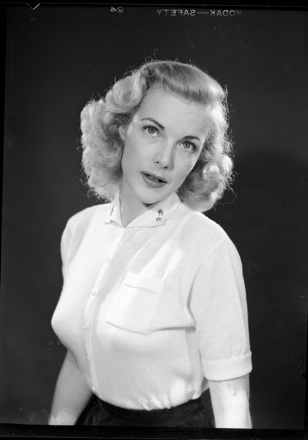The North Carolina Azalea Festival is in progress for the 72nd time in Wilmington. This year’s event takes place from April 3-7, 2019. Going back to 1948, not only is this event a celebration of flowers and golf, it brings celebrated guests from across the United States. From Hollywood movies, to TV stars, to celebrated sports heroes, the festival has seen them all. Over the years, many of the guests have made returned visits. This was especially true in the early years. As we celebrate festival number 72, Morton collection volunteer Jack Hilliard looks back at one of those guests, noted broadcaster Harry Wismer, who visited often during the1950s.
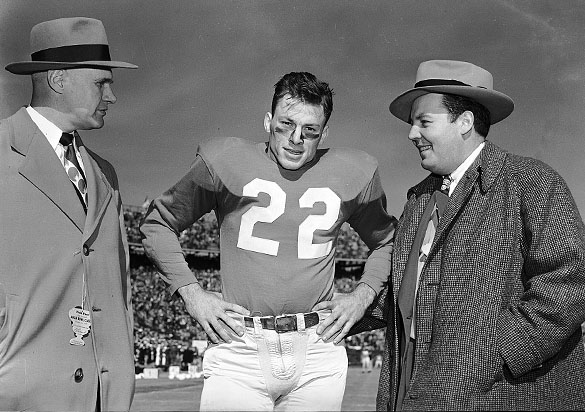
Hugh Morton crossed paths with legendary sportscaster Harry Wismer at the Sugar Bowl on January 1, 1949 in New Orleans. Wismer was in town to broadcast the game for ABC Radio between the UNC Tar Heels and the Oklahoma Sooners. Of course Morton was in town to photograph the game which featured his dear friend Charlie Justice. And as one would expect, Morton took at pre-game picture of Justice and Wismer, a picture that Hugh often included in his famous slides shows. Morton also included the image in his 1988 book Making a Difference in North Carolina on page 257.
Nearly two years later on December 10, 1950, Morton photographed the final regular season game between the Washington Redskins and the Cleveland Browns in Washington’s Griffith Stadium. Again, he crossed paths with Harry Wismer, the Redskins’ play-by-play man. At the time, Harry Wismer, who was known by many as “The Whiz,” was already considered the nation’s leading sportscaster, having broadcast numerous events like the National Open and PGA, the Penn Relays, and the National Football League Championship.
Wismer was also a part owner of the Detroit Lions and the Washington Redskins of the National Football League. In addition to his co-ownership, Wismer was “The Voice of the Redskins,” having called their games on the “Amoco-Redskins Network” since 1943. It was on those Redskins’ broadcasts that I first heard him. As a little kid, I listened to the Redskin games starting in 1950. When the game came to TV in North Carolina in 1951, Wismer was right there with the play-by-play. I remember those early broadcasts. Wismer’s commercial tag line went like this: “All around town, for all around service, visit your Amoco man, and Lord Baltimore filling stations.”
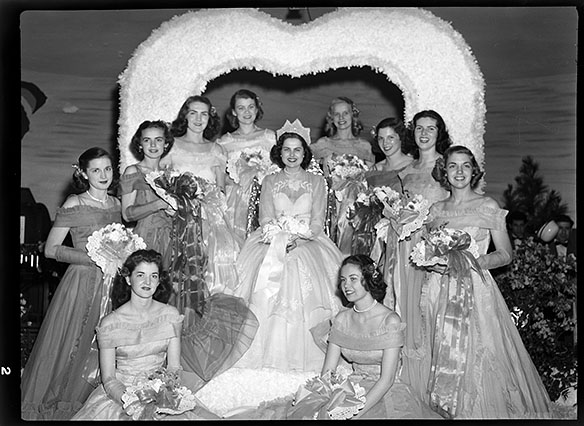
Starting in 1949, the Azalea Open Golf Tournament became a part of the spring festivities. Hugh Morton invited Wismer to the 1950 Azalea Festival in Wilmington, along with Southern Methodist University football hero Doak Walker and his wife Norma. Of course, Tar Heels Charlie and Sarah Justice returned in ’50, having been there in 1949 to crown Azalea Queen II, Hollywood starlet Martha Hyer. When Justice and Wismer returned to Wilmington for the 1951 festival, Hugh Morton had added a new event: a special golf match at the Cape Fear Country Club called “Who Crowns the Azalea Queen?” The match pitted two ABC Radio broadcasters, Harry Wismer and Ted Malone, against two football greats, Charlie Justice and Otto Graham.


The winner of the nine–hole–event would have the honor of crowning Queen Azalea IV, Margaret Sheridan. The ‘51 winner was the Justice/Graham team.
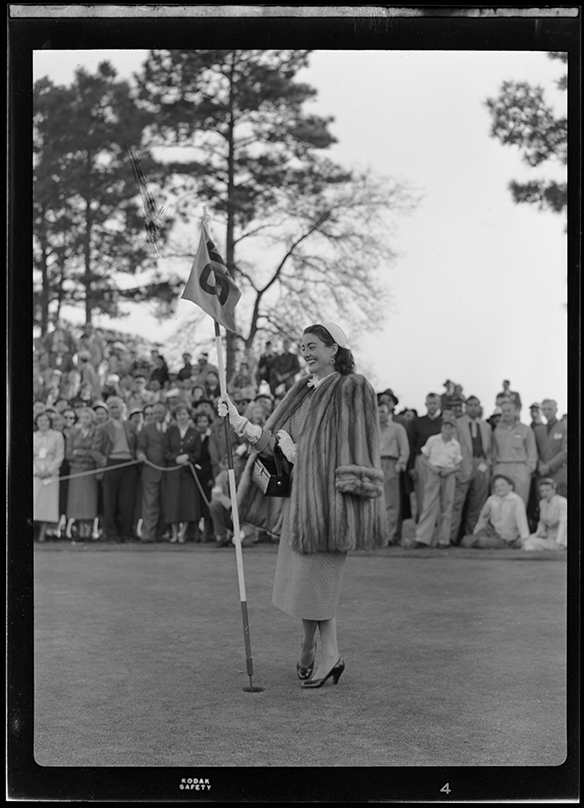
In addition to being part of the parades, flowers, and parties, Wismer broadcast the Azalea Open Golf Tournament on ABC Radio. The 1951 Open winner was Lloyd Mangrum, and Wismer included an interview with him on his ABC Radio show which was also originated live in Wilmington.
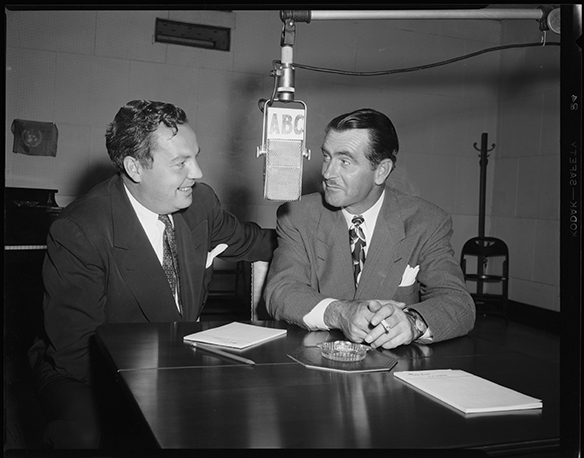
The 1952 “Who Crowns the Azalea Queen?” event once again put Wismer’s team, which included writer Hal Boyle and band leader Tony Pastor, against a football squad of Charlie Justice, Eddie Lebaron, and Otto Graham and this time the Wismer team won.

According to Hugh Morton, the original queen selection for 1952 was actress Janet Leigh, but her husband Tony Curtis decided to cancel their trip to Wilmington. Morton knew that actress Cathy Downs was in town because her husband Joe Kirkwood, Jr. was playing in the Azalea Open. When Morton invited her, she accepted and became Queen Azalea V.
Wismer continued his Azalea Festival visits during the mid-1950s. Charlotte broadcaster Grady Cole also participated in Wismer’s broadcasts.
Wismer would later become one of the founding fathers of the American Football League, which began play in 1960; three years later, however, he gave up his football leadership. Wismer spent the remainder of his life trying to reclaim his glory days as broadcaster and team owner, but was unsuccessful partly because of his declining health. In 1965, Wismer wrote a book titled The Public Calls It Sports. In it he gives a “behind the scenes” look at professional football from a broadcast and ownership point of view.
Harry Wismer passed away on December 4, 1967, the day after a tragic fall at a New York restaurant. He was 64-years-old.
Category: Azalea Festival
A festival like no other . . . the beginning
The 71st annual North Carolina Azalea Festival will take place in Wilmington beginning today, April 11th, and will run through the 15th, 2018. Thousands of visitors will gather in the port city to take part in the city’s premier event. In addition to the millions of beautiful flowers, there will be a wide variety of entertainment, a parade, and the famous crowning ceremony of Queen Azalea LXXI . . . just as it has been since 1948. Morton Collection volunteer Jack Hilliard looks back to 1948 and the beginning of this North Carolina tradition.
When Hugh Morton presented his slide shows across North Carolina, he almost always included slides from the first Azalea Festival. In addition to his magnificent photography, he would add a few light-hearted remarks about how he became the point-man for that first event in 1948. According to Morton, the story went something like this.
Prominent Wilmington physician Dr. Houston Moore had an idea as far back as 1934 to celebrate Wilmington’s magnificent azaleas. Then in the early 1940s he came up with the festival idea. In 1947 he invited Wilmington’s major civic clubs to select one or two representatives to attend a festival organizational meeting. Morton was there representing the Wilmington Jaycees. April, 1948 was selected for that first festival. When the second planning session was held, Morton was out of town on business, but when he returned he learned that he had been elected president for the first festival. Morton said he respectfully declined, but Dr, Moore was a very persuasive gentlemen, so Morton took charge and put his magnificent public relation skills to work on the first annual North Carolina Azalea Festival, held April 9h through April 11th, 1948.
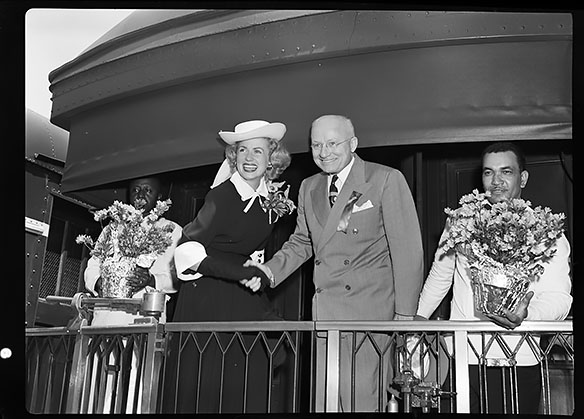
The unofficial celebration for the first festival got underway at 12:30 p.m. on Thursday, April 8th with the arrival of Queen Azalea I: Jacqueline White, RKO movie actress from Hollywood. Wilmington mayor E. L. White and a formal reception committee . . . plus a long line of autograph-seekers greeted Miss White at the Atlantic Coast Line train station. She very graciously signed and spoke with many in the long line.
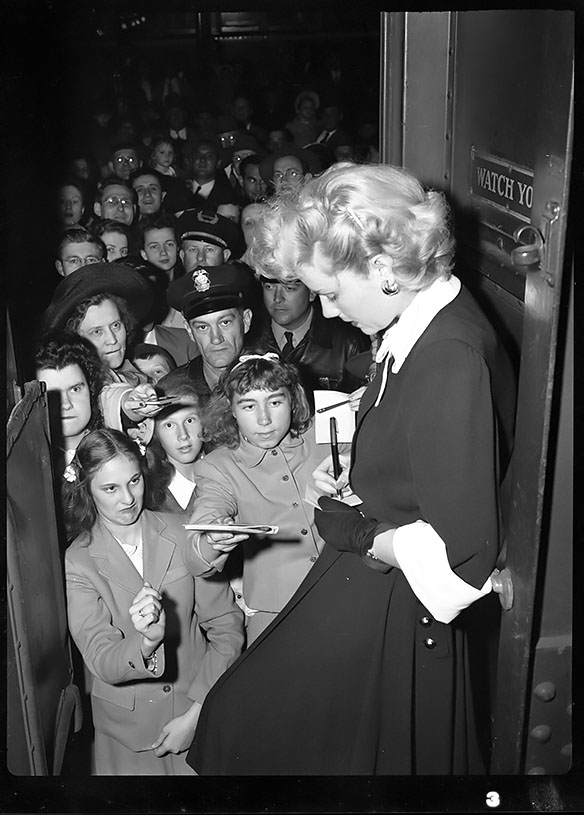
Later that evening, Wilmingtonians greeted a second queen, Mrs. Barbara Randall, who had been selected “Queen for a Day” on the Mutual Radio broadcast the preceding day. A trip to Wilmington was part of her prize.
Friday, April 9th was a beautiful spring day as a festival spirit filled the city. Flower shows and visits to the famed Greenfield Park, Orton Plantation, and Airlie Gardens were high on the priority list. At 11:45 a.m., ABC Radio’s Ted Malone broadcasted his nationwide radio program from a platform set up in front of Community Center. A crowd of about 2,000 turned out for the broadcast.
On Friday evening, more than 4,000 people turned out for a band concert at Legion Stadium, featuring the New Hanover High School Band. Following the band concert, the New Hanover High School Choral groups performed along with the Atlantic Coast Line Choral performers. In all more than 600 musicians took part in the concert. The evening’s festivities closed with a community sing along, concluding with the “Hallelujah Chorus” from George Frideric Handel’s Messiah.
Long before the parade moved off from Front and Castle Streets at 11:04 a.m. on Saturday, April 10th, a huge crowd was in place for prime viewing. The mile-long parade of sixteen floats, five marching bands and two military units, with Queen Jacqueline near the front. The parade made its way through downtown, passing North Carolina Governor R. Gregg Cherry, Mayor White, and Queen Barbara Randall seated at the official viewing stand at City Hall and then back to its point of origin.
The closing and festival highlight event was held in Lumina Hall at Wrightsville Beach on Saturday evening. At that time, Queen Jacqueline was officially crowned by North Carolina Governor R. Gregg Cherry.
One of Hugh Morton’s favorite Azalea Festival photographs from the 1948 event was that of Governor Cherry crowning Queen Jacqueline. A close look at the image shows the governor has the crown upside down. Morton loved to explain how that misstep occurred.
Governor Cherry came down to crown our first azalea queen, Jacqueline White of RKO Radio Pictures. He had been in the National Guard with a group of Wilmingtonians, with whom he felt he always had to have a drink. (A separate toast for each Guard member.) When time for the coronation arrived, the Governor was ‘toasted-out’ and a bit unstable on his feet as he put the crown on upside down. Master of ceremonies, Carl Goerch publisher of The State and Chairman of the coronation ball, died a thousand deaths.

Queen Jacqueline smiled and kept her composure as the crown was then placed correctly on her head. Following the coronation there was dancing with music by Bob Astor and his orchestra. At day’s end, “it was quite an evening for Hugh Morton,” as author Susan Taylor Block said in her 2004 book, Belles & Blooms: Cape Fear Garden Club and the North Carolina Azalea Festival. “He had ushered Dr. Moore’s dream into reality and witnessed the crowning event in Lumina, the pavilion created by his grandfather, Hugh MacRae, and named by his mother Agnes.”
Fifty-five years later, in a 2003 interview, Morton described that first festival. “When the first Azalea Festival took place in April 1948 the gardens were at peak beauty, the weather was perfect, and the Festival cleared $5,000, a profit we knew we had to have or we would never see the second Festival.”
Today, the North Carolina Azalea Festival continues in its 71st year as a festival like no other.
Epilog
Another of Hugh Morton’s most reproduced photographs from the 1948 Azalea Festival was his image of Queen Jacqueline White seated under the Airlie Oak.
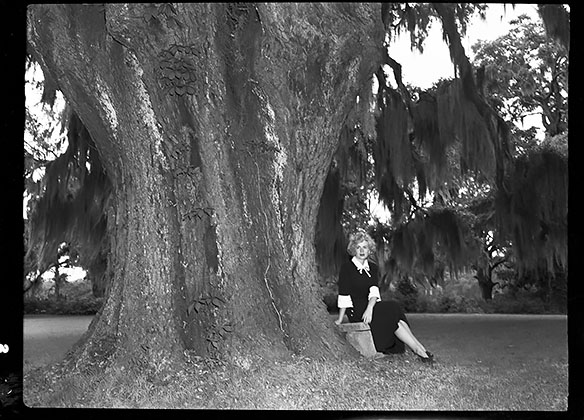
When the Festival celebrated its 25th anniversary in the spring of 1972, Jacqueline White Anderson returned as a special guest. And, as you might expect, Hugh Morton took her over to the Arlie Oak for yet another memorable photograph.
You can see more than 150 Azalea Festival photographs made by Hugh Morton in the online collection, plus explore even more by searching through the Morton collection finding aid.

“Mighty Mites,” Morton, and millions of azaleas
The 67th Annual North Carolina Azalea Festival will be presented in Wilmington April, 9 – 13, 2014. World class entertainment and millions of azaleas will combine to welcome spring to the Tar Heel state again. Wilmington’s celebration of spring began in 1948 and each year celebrity guests have been an important part of the festivities. Morton collection volunteer/contributor Jack Hilliard takes a look at a special group of celebrities that came to the New Hanover County port city back in the 1950s.

A Prologue:
When the 1950 College All-Star football team reported to training camp at St. John’s Military Academy in Delafield, Wisconsin on Thursday, July 20, 1950, UNC’s great All America football star Charlie Justice met up with his old friend Doak Walker from Southern Methodist University (SMU) and new friend Eddie LeBaron from College of the Pacific (COP), which is now University of the Pacific. Justice and Walker had become friends over the years when both were on most of the 1948 and 1949 All America teams and both had been pictured on the cover of Life. Walker had been selected for the 1948 Heisman Trophy while Justice was first runner up. And when UNC was in Dallas for the 1950 Cotton Bowl, Walker had helped the Tar Heels prepare for a game with Rice Institute (now Rice University). Walker’s SMU team had played and lost to Rice, 41 to 27, on October 21st. Hugh Morton photographed Justice, Walker and UNC Head Coach Carl Snavely during one of the film screening sessions at the Melrose Hotel. Also, Justice and Walker had gotten into the T-shirt business in early 1950 and Morton had done their publicity pictures. Quarterback Eddie LeBaron had been selected All America in 1949 as well, and the three “country boys” hit it off. All three loved watermelon and on the first day of camp they staked out a small country store which sold melons. “Put one on ice every afternoon,” Charlie told the store owner, “and we’ll come by and pick it up.” So every afternoon after practice the trio walked to the store, purchased their chilled melon, took it outside and sat on the curb enjoying the treat.
When game day arrived on August 11, 1950, the three “Mighty Mites,” as they were called (each was under six feet tall and weighed less than180 pounds) took the World Champion Philadelphia Eagles down by a score of 17 to 7. Hugh Morton didn’t attend the All-Star game, but he always included a wire photo from it in his slide shows.
❀ ❀ ❀ ❀ ❀ ❀ ❀
Back in Wilmington after the War, I left town for a week, and while I was gone the local folks elected me chairman of the first Azalea Festival in 1948. —Hugh Morton, 1996
The Dallas Morning News issue of Saturday, March 18, 1950 featured the storybook, Friday night wedding of Doak Walker and his college sweetheart Norma Peterson. The story said the couple would leave for a wedding trip to Canada “early next week . . . and will take another trip to North Carolina soon after they return.” That North Carolina trip would be to the 1950 Azalea Festival in Wilmington, held March 30th through April 2nd.
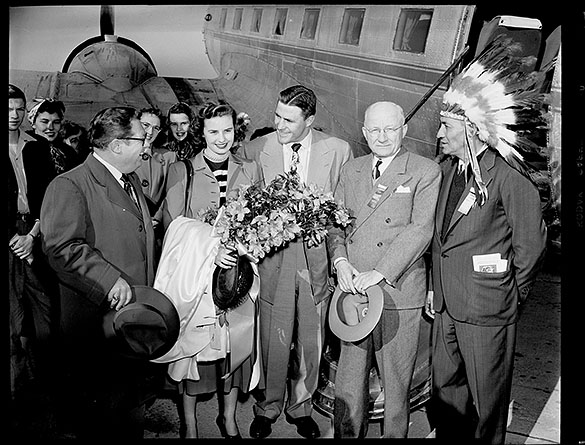
Hugh Morton photographed Doak and Norma soon after they arrived in Wilmington. Hugh’s wife Julia said in A View Hugh comment back in 2009, “I do remember that Doak and Norma and Charlie and Sarah (Justice) stayed with Hugh and me. The festival didn’t have as much available money back in those days, and they were our friends.”
Charlie and Sarah Justice had been part of the 1949 festival. Charlie had crowned Queen Azalea II who was movie star Martha Hyer and many remember how the photographers covering that event had insisted that Justice kiss the Queen and he very obligingly followed through on the request. Morton’s photograph in The State for April 16, 1949 (page 5) showed Justice with lipstick on his face. (The original negative for this shot is no longer extant, but there is a similar negative made moments apart.)

During the 1950 festival, Morton took several pictures of Doak and Charlie, and Norma and Sarah: a beautiful shot of both couples at Arlie Gardens, and a shot from the parade on Saturday, April 1st. The parade image was reproduced in the 1958 Bob Quincy–Julian Scheer book, Choo Choo; The Charlie Justice Story, on page 112. The same picture was also included in the 2002 Bob Terrell book All Aboard, but with an incorrect caption. That image is on page 182. And of course, The State magazine issue of April 15, 1950 (page 3) included a Morton picture of Justice and Walker at the crowing ceremony where Justice passed the crown to Walker who crowned Gregg Sherwood as Queen Azalea III.
When Charlie and Sarah arrived in Wilmington for the 1951 festival, Hugh Morton had put in place a new event. On Saturday afternoon, March 31st, there was a special golf match at the Cape Fear Country Club. It was called “Who Crowns the Azalea Queen?” and it pitted broadcasters Harry Wismer and Ted Malone against football greats Charlie Justice and Otto Graham—nine holes—winners crown Queen Margaret Sheridan Queen Azalea IV. And the winners . . . Charlie Justice and Otto Graham.
The day following the 1950 All-Star game, Eddie LeBaron left for Camp Pendleton and Marine duty. He would spend nine months in Korea and would receive a letter of commendation for heroism, a Bronze Star and a purple heart. Lt. Eddie LeBaron was back home in time to accept Hugh Morton’s invitation to the 1952 Azalea Festival. Again, as in 1951, there was a “Who Crowns the Azalea Queen?” golf match. This time with ABC broadcaster Harry Wismer, writer Hal Boyle, bandleader Tony Pastor, and football greats Justice, LeBaron, and Otto Graham. The football guys won and would be part of the crowning ceremony for Queen Azalea V, Cathy Downs. A tightly cropped version of Morton’s crowning shot is also in Chris Dixon’s 2001 book Ghost Wave (unnumbered center picture page).
Later, in November, 1952, Hugh Morton took in a Washington Redskins game and photographed Justice, LeBaron, and Graham at Old Griffith Stadium.
In March of 1953, Charlie and Sarah Justice made their fifth Festival appearance as Alexis Smith became Queen Azalea VI on Saturday, March 28th.
Eddie LeBaron would return to Wilmington for the ‘58 Festival, along with Andy Griffith who crowned Queen Azalea XI, Esther Williams on March 29, 1958. Morton photographed LeBaron with Andy and NC Governor Luther Hodges.
The “Mighty Mites” were special Azalea Festival guests and were special friends of Hugh Morton, who in 1997, at the 50th Festival was honored with a star on the Wilmington Riverfront Walk of Fame and was the Festival Grand Marshal.
An Epilogue:
Doak Walker’s marriage to Norma Peterson ended in divorce in 1965 and four years later he married Olympic skier Skeeter Werner. They lived in Steamboat Springs, Colorado until his death as a result of paralyzing injuries suffered in a skiing accident. Walker’s death on September 27, 1998 came ironically 50 years to the day of his Life magazine cover issue.
Prior to the planning sessions for the Charlie Justice statue, which now stands outside the Kenan Football Center on the UNC campus, Hugh Morton visited the Doak Walker statue at SMU. Morton decided, unlike the Walker statue, that Charlie would not wear his helmet so everyone could easily recognize him.
Charlie Justice passed away on October 17, 2003 following a long battle with Alzheimer’s. Charlie’s wife Sarah died four months later.
Hugh Morton “slipped peacefully away from us all on June 1, 2006.” Those words from Morton’s dear friend Bill Friday.
Eddie LeBaron played professional football with Charlie Justice for two seasons with the Washington Redskins. After Charlie’s retirement, the two remained close friends. LeBaron participated in a Multiple Sclerosis Celebrity Roast for Charlie in 1980, and both were Hugh Morton’s guests at the Highland Games in 1984. Justice and LeBaron were also celebrity guests at the Freedom Classic Celebrity Golf Tournament in Charlotte in 1989 and 1990. LeBaron lives in Sacramento, California and continues to play golf in his retirement. Due to his diminutive size, 5 feet, 7 inches, and his leadership skills from his military service, he is often called the “Littlest General.”
Final weeks for "Photographs by Hugh Morton: An Uncommon Retrospective"
Just wanted to float a reminder out there that the exhibit “Photographs by Hugh Morton: An Uncommon Retrospective” is entering its final two weeks at the Turchin Center for the Visual Arts at Appalachian State University.
Are you going to be in the mountains for a bit of skiing this weekend, but the weather forecast calls for rain on Saturday? Just looking for something to do in Boone? Swing on over to the Turchin Center, view the fabulous photography by Hugh Morton, and stay dry!
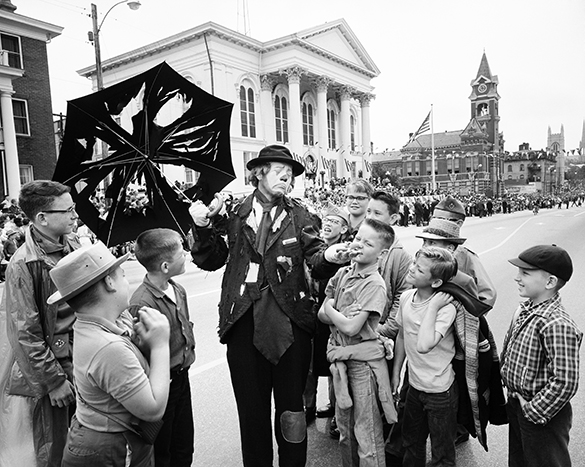
Perhaps the world’s most recognizable clown, Emmett Kelly, Jr. sprung into international fame soon after completing his four-year apprenticeship in 1964. Hired by Kodak as the attraction for its pavilion during the 1964-1965 New York World’s Fair, the company employed Kelly as a touring Ambassador of Goodwill for the following four years. During that time period, Kelly was the most photographed clown in the world, including this one by Hugh Morton—a founder and organizer of the azalea festival.
Here are the gallery hours at the Turchin Center:
- Tue: 10am – 6pm
- Wed: 10am – 6pm
- Thu: 10am – 6pm
- Fri: 12noon – 8pm
- Sat: 10am – 6pm
Can’t make it to Boone before the exhibit’s last day on January 25th? Fear not! We have two additional venues in the works for this year: one farther west this spring and another in the east during the late summer and autumn. I’ll be posting more information as the details unfold.
Revealing X-ray
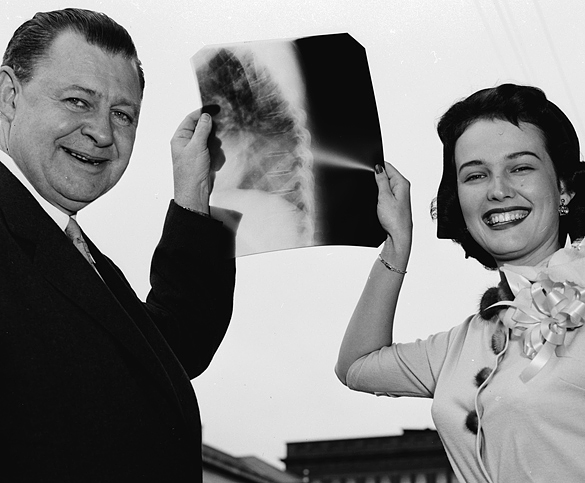
Today marks the discovery of the X-Ray . . . and a post that reveals the story behind A View to Hugh mystery from 2008. On this day in 1895, physicist Wilhelm Conrad Rontgen was the first person to observe X-rays. This important scientific discovery ultimately led to the Hugh Morton photograph seen above, cropped as it appeared in the Wilmington Morning Star on March 31st, 1954. (You can see the full-negative version with its descriptive information by clicking on the photograph.)
Back in April 2008, Elizabeth Hull included this photograph in a Who Am I? post for the Azalea Festival. Lots of comments from readers eventually led Elizabeth to discover that the woman was Neva Jane Langley, Miss America 1953. One commenter speculated that Langley and Grady Cole might be holding an X-ray related to a tuberculosis display at the 1954 Azalea festival.
Today’s science anniversary prompted me to search for the word “X-ray” in the online collection of Morton photographs. Two similar images of Cole and Langley were the only hits, so I turned to the blog post from four years ago. The unresolved speculation in the comments about tuberculosis and that the event could be from the 1954 festival led me to the microfilm room and the Wilmington newspaper for March 1954.
Langley arrived in Wilmington at Bluethenthal Field on Friday, March 26th around 5:00 p.m. Hugh Morton and Grady Cole formed the welcoming committee, with Morton at the wheel of the car that whisked away the reigning beauty queen from the airport. The next day, Langley was to participate in the Azalea Festival Coronation Ball, and Cole was to be its master of ceremonies, so it was a logical choice for Cole to be her official greeter.
Saturday evening was rainy at Wrightsville Beach, where the coronation ball was to take place at the Lumina Ballroom. Here’s the Sunday Star-News account of something that happened that night:
Cole’s Sir Walter Act Ends In Pain
Grady Cole—”Mr. Dixie” of Radio Station WBT Charlotte—did Sir Walter Raleigh one better with Miss America at the Azalea Festival Coronation Ball last night and was in the hospital today with what is believed to be a dislocated vertebra.
Hugh Morton, co-chairman of the festival’s invitations committee, said that during the downpour at Wrightsville Beach Cole carried Neva Jane Langley of Lakeland, Fla.—Miss America of 1953—over puddles of water and up the stairs of Lumina Ballroom. Miss Langley was an honorary celebrity at the crowning of the Azalea Festival Queen—movie and television actress Ella Raines—by Gen. Mark Clark.
Cole carried on his duties as master of ceremonies of the Coronation Ball, then was rushed by the highway patrol to James Walker Memorial Hospital. Morton said it is believed that Cole dislocated a vertebra with his gallantry.
A few days after the festival, the photograph above ran uncredited on the back page of the March 31st Wilmington Morning Star with the following caption:
POSITIVE PROOF — Grady Cole Radios’s “Mr. Dixie,” of WBT, Charlotte and the CBS Network, is shown holding an X-ray of his spine, which was injured at the Azalea Festival Coronation Ball Saturday night when Grady carried Miss Neva Jane Langley, “Miss America of 1953,” across a mud puddle in a heavy downpour of rain. Miss Langley is shown holding the X-ray which revealed that Cole sustained what doctors call “a compressed fracture of his sixth vertebra.” Doctors told Cole he could “never lift a pretty girl again,” and he philosophically replied, “we all have to quit sometime and I’m glad I quit with the best.”
Where in Wilmington did Morton take the photograph? On the right side of the full image, a few business signs are visible. One appears to be for the Cape Fear Dining Room, which was in the Cape Fear Hotel at 121–131 Chestnut Street. Today the building is home to the Cape Fear Hotel Apartments. In the background on the opposite side of the street, the shorter building on the left is the United States Post Office. The building on the right is the Southern Building, which sat on the southwest corner of Chestnut and Front streets.
Picturing the Port City

With the 63rd Annual North Carolina Azalea Festival kicking off next week, it seems an appropriate time to highlight the festival’s home turf: Wilmington, NC. Not only was Hugh Morton was born and raised in Wilmington, but he and his family played a major role in shaping the tourism industry and infrastructure of the charming, historic Port City.
Here to help us is another Wilmington native, author, and purveyor of all things Wilmington history-related, Susan Taylor Block. Susan is the author of a whole bunch of books and articles (including photographic histories) on Wilmington’s past, culture, and some of its residents. She’s also behind the latest entry in our Worth 1,000 Words series, entitled Wilmington: Faded Glory to Fresh Achievement.
We hope you’re enjoying the growing variety of the essay offerings, and the opportunity they offer to delve a bit deeper into the riches of the Morton collection.
Azalea Festival memories
It’s that time of year again — the shrubs are blooming, the Queen has been selected, and Wilmington is all geared up for the 62nd annual celebration of “all that is Southern” — the NC Azalea Festival, which begins this week.
Stephen forwarded me a link to a charming article from last week’s Star News in which longtime Wilmingtonian Thurston Watkins, Jr. “remembers splendid, scandalous events from past Azalea Festivals.” In skimming through the article, I realized we had Morton images to illustrate many of the choice moments Watkins recalls. A few are included below.
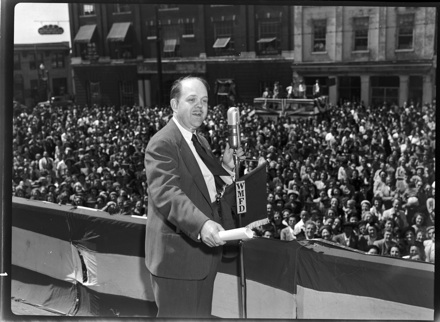
Watkins reports: “Announcement of our festival to all points was accomplished by Ted Malone’s coast-to-coast radio show. Malone had mastered the art of descriptive English and would be considered an equal to Charles Kuralt’s abilities many years later.”
Watkins reports: “I remember the festival having a ‘close call’ with Queen trouble. Janet Leigh had agreed to be our Queen, but just before she was to arrive, her husband, Tony Curtis, canceled the deal. Hugh Morton was aware of a movie star, Cathy Downs, accompanying her husband at the Azalea Golf Tournament and approached her with our problem. She agreed to be the ‘short notice Queen’ and they secretly took her to Fayetteville and put her on a plane back to Wilmington. The arrival ceremonies turned out just fine and her ‘royal subjects’ never knew she hadn’t made the trip from Hollywood.” (The year was 1952, and Morton took several stunning portraits of Downs, including the one above).
And finally, one Watkins memory I just have to correct. He recalls “a ‘tipsy’ Wilmington Mayor crowning a Queen Azalea at Lumina, Wrightsville Beach—with the crown upside down—then proceeding to almost fall off the stage.” That tipsy mayor was actually the Governor of North Carolina, R. Gregg Cherry, who crowned the very first Azalea Queen, Jacqueline White.
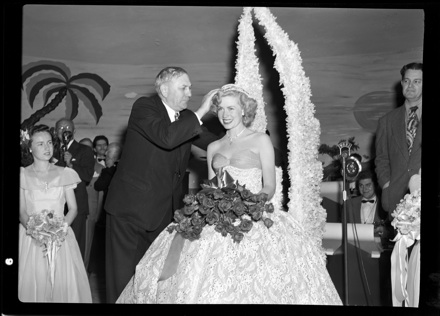
As Susan Taylor Block recounts on page 26 of her book on the Azalea Festival, Belles and Blooms:
At her coronation ball at Lumina, Miss White’s composure was tested when Governor R. Gregg Cherry crowned her Queen Azalea I. The first citizen of NC had been in town all day, enjoying seeing a number of old friends. After spending hours socializing, the elderly gentleman was somewhat overdosed on Southern hospitality. He teetered dangerously close to the edge of the stage before placing the crown upside down on Miss White’s head.
This detail of Morton’s photo shows the upside-down crown:

Who Am I?–North Carolina Azalea Festival Edition
 Wilmington’s 61st annual North Carolina Azalea Festival kicks off next week (April 9-13). Hugh Morton played an integral role in the event’s founding: while only in his twenties, he was selected to serve as president of the inaugural festival in 1948. (A letter from Morton on the festival’s website explains that when he missed a committee meeting, they responded by electing him president). As Susan Taylor Block writes in “Clan MacRae,” an article in the 4/2007 issue of Wrightsville Beach magazine, Morton deserves credit not only for Wilmington’s Azalea Festival, but also many of its azalea plants:
Wilmington’s 61st annual North Carolina Azalea Festival kicks off next week (April 9-13). Hugh Morton played an integral role in the event’s founding: while only in his twenties, he was selected to serve as president of the inaugural festival in 1948. (A letter from Morton on the festival’s website explains that when he missed a committee meeting, they responded by electing him president). As Susan Taylor Block writes in “Clan MacRae,” an article in the 4/2007 issue of Wrightsville Beach magazine, Morton deserves credit not only for Wilmington’s Azalea Festival, but also many of its azalea plants:
Morton had worked diligently since 1946 to make the 1948 Azalea Festival debut a success. He encouraged Wilmingtonians to plant azaleas, persuaded the local government to plant an additional 175,000 azaleas at Greenfield Lake and recruited garden clubs to transplant azaleas from their own private gardens to public spaces. Morton encouraged the festival fathers to be careful stewards of the event’s ticket take, seek out quality in celebrity guests and make the azalea itself the guest of honor. He knew that if the first festival ended up in the red, it would be the last.
North Carolina Azalea Festival negatives in the Morton collection are numerous and mostly in good shape, but not well-documented. The early years of the festival (from 1948 to about 1958) are best represented, but little identifying information is provided other than the year (if that). Fortunately, we have at least one good source to work from—historian Block’s 2004 book Belles & Blooms, heavily illustrated by Morton’s photos. Block’s time line will help us pin down some of the major details, like who was queen in what year, what celebrities attended, etc.
In the meantime, though, we’re asking you to help us put names to faces in some of these early shots.
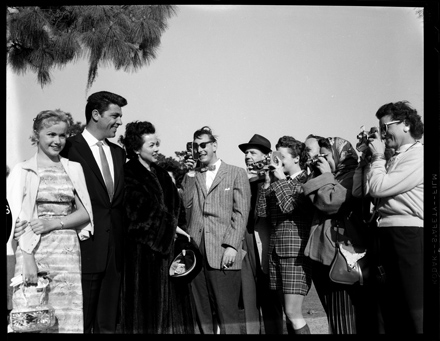
Judging from the enormous fur coat and all the cameras pointed at them, I’m guessing that these people are famous. But who are they?
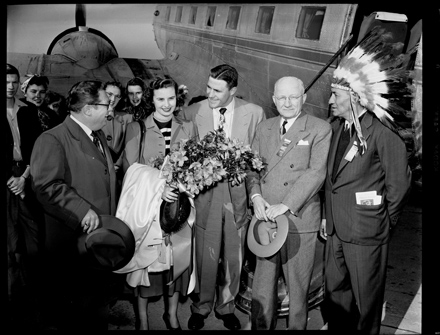
The image above was taken at the 1950 Azalea Festival. I can’t read any of the name tags, but I do see that the man on the far right (in the headdress) has a program from “Unto These Hills” (an outdoor drama performed at Cherokee, North Carolina) in his pocket.

The man in this photo is Grady Cole, talk radio celebrity with WBT Radio in Charlotte, North Carolina (and frequent Morton photo subject in the early 1950s). But who is the woman—and is she the same woman from the previous photo? Most importantly, why are they holding up what looks like an x-ray of somebody’s spine?!

